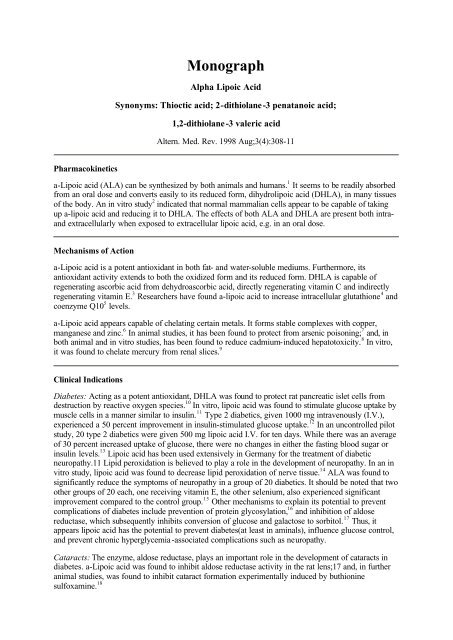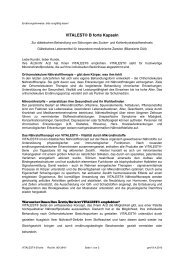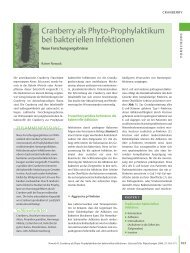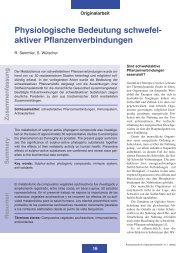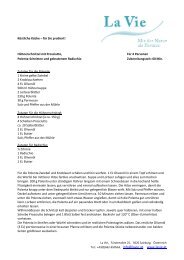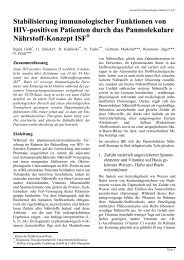Monograph - La Vie
Monograph - La Vie
Monograph - La Vie
You also want an ePaper? Increase the reach of your titles
YUMPU automatically turns print PDFs into web optimized ePapers that Google loves.
Pharmacokinetics<br />
<strong>Monograph</strong><br />
Alpha Lipoic Acid<br />
Synonyms: Thioctic acid; 2-dithiolane-3 penatanoic acid;<br />
1,2-dithiolane-3 valeric acid<br />
Altern. Med. Rev. 1998 Aug;3(4):308-11<br />
a-Lipoic acid (ALA) can be synthesized by both animals and humans. 1 It seems to be readily absorbed<br />
from an oral dose and converts easily to its reduced form, dihydrolipoic acid (DHLA), in many tissues<br />
of the body. An in vitro study 2 indicated that normal mammalian cells appear to be capable of taking<br />
up a-lipoic acid and reducing it to DHLA. The effects of both ALA and DHLA are present both intra-<br />
and extracellularly when exposed to extracellular lipoic acid, e.g. in an oral dose.<br />
Mechanisms of Action<br />
a-Lipoic acid is a potent antioxidant in both fat- and water-soluble mediums. Furthermore, its<br />
antioxidant activity extends to both the oxidized form and its reduced form. DHLA is capable of<br />
regenerating ascorbic acid from dehydroascorbic acid, directly regenerating vitamin C and indirectly<br />
regenerating vitamin E. 3 Researchers have found a-lipoic acid to increase intracellular glutathione 4 and<br />
coenzyme Q10 5 levels.<br />
a-Lipoic acid appears capable of chelating certain metals. It forms stable complexes with copper,<br />
manganese and zinc. 6 In animal studies, it has been found to protect from arsenic poisoning; 7 and, in<br />
both animal and in vitro studies, has been found to reduce cadmium-induced hepatotoxicity. 8 In vitro,<br />
it was found to chelate mercury from renal slices. 9<br />
Clinical Indications<br />
Diabetes: Acting as a potent antioxidant, DHLA was found to protect rat pancreatic islet cells from<br />
destruction by reactive oxygen species. 10 In vitro, lipoic acid was found to stimulate glucose uptake by<br />
muscle cells in a manner similar to insulin. 11 Type 2 diabetics, given 1000 mg intravenously (I.V.),<br />
experienced a 50 percent improvement in insulin-stimulated glucose uptake. 12 In an uncontrolled pilot<br />
study, 20 type 2 diabetics were given 500 mg lipoic acid I.V. for ten days. While there was an average<br />
of 30 percent increased uptake of glucose, there were no changes in either the fasting blood sugar or<br />
insulin levels. 13 Lipoic acid has been used extensively in Germany for the treatment of diabetic<br />
neuropathy.11 Lipid peroxidation is believed to play a role in the development of neuropathy. In an in<br />
vitro study, lipoic acid was found to decrease lipid peroxidation of nerve tissue. 14 ALA was found to<br />
significantly reduce the symptoms of neuropathy in a group of 20 diabetics. It should be noted that two<br />
other groups of 20 each, one receiving vitamin E, the other selenium, also experienced significant<br />
improvement compared to the control group. 15 Other mechanisms to explain its potential to prevent<br />
complications of diabetes include prevention of protein glycosylation, 16 and inhibition of aldose<br />
reductase, which subsequently inhibits conversion of glucose and galactose to sorbitol. 17 Thus, it<br />
appears lipoic acid has the potential to prevent diabetes(at least in aminals), influence glucose control,<br />
and prevent chronic hyperglycemia-associated complications such as neuropathy.<br />
Cataracts: The enzyme, aldose reductase, plays an important role in the development of cataracts in<br />
diabetes. a-Lipoic acid was found to inhibit aldose reductase activity in the rat lens;17 and, in further<br />
animal studies, was found to inhibit cataract formation experimentally induced by buthionine<br />
sulfoxamine. 18
Glaucoma: Lipoic acid, at dosages of either 75 mg daily for two months or 150 mg daily for one<br />
month, was administered to 75 subjects with open-angle glaucoma. Thirty-one others served as<br />
controls and were given only local hypotensive therapy. The greatest improvements in both<br />
biochemical parameters of glaucoma and visual function were seen in the group receiving 150 mg<br />
lipoic acid. 19<br />
Ischemia-Reperfusion Injury: After an area has been deprived of blood for a period of time, such as<br />
occurs in the brain after a stroke or in cardiac tissue after clot dissolution, reperfusion of the tissues<br />
causes a burst of free radical formation. Several animal studies have demonstrated the effectiveness of<br />
DHLA in the prevention of reperfusion injury. 20-24 Amanita mushroom poisoning: a-Lipoic acid<br />
infusions were used in the treatment of amanita mushroom poisoning in 75 patients between 1974 and<br />
1978. While 10-50 percent of patients recover without intervention, 89 percent (67 of 75) recovered<br />
after lipoic acid infusion. 25<br />
Alcoholic Liver Disease: Although preliminary studies have indicated possible benefit of lipoic acid in<br />
the treatment of alcoholic liver disease, the only controlled, double -blind, study found ALA had no<br />
significant influence on the course of the disease. 26<br />
Other possible effects: Other potential therapeutic uses for ALA or DHLA include: protection from<br />
radiation injury, prevention of neurological disorders by preventing oxidative damage of the central<br />
nervous system, 27 prevention of HIV viral replication by inhibition of reverse transcriptase, 28<br />
protection from the effects of cigarette smoke, and treatment of heavy metal toxicity. 27 These are<br />
interesting theoretical considerations requiring further research.<br />
Dosage<br />
Recommended therapeutic dosage of a-lipoic acid is in the range of 300-600 mg/day taken orally.<br />
Safety, Toxicity and Side Effects<br />
a-Lipoic acid appears to be safe in the dosages generally prescribed clinically. The LD50 was 400-500<br />
mg/kg after an oral dosage in dogs. 27 However, lower dosages (20 mg/kg) given intraperitoneally to<br />
severely thiamin-deficient rats proved fatal. These adverse effects were prevented when thiamin was<br />
administered with the lipoic acid. 29 There have not been sufficient studies to guarantee safety for its<br />
use in pregnancy. Allergic skin conditions are among the few reported side effects of lipoic acid<br />
administration in humans.<br />
References<br />
1. Carreau JP. Biosynthesis of lipoic acid via unsaturated fatty acids. Methods Enzymol 1979;62:152-<br />
158.<br />
2. Handelman GJ, Han D, Tritschler H, Packer L. a-Lipoic acid reduction by mammalian cells to the<br />
dithiol form and release into the culture medium. Biochem Pharmacol 1994;47:1725-1730.<br />
3. Scholich H, Murphy ME, Sies H. Antioxidant activity of dihydrolipoate against microsomal lipid<br />
peroxidation and its dependence on a-tocopherol. Biochem Biophys Acta 1989;1001:256-261.<br />
4. Busse E, Zimmer G, Schopohl B, et al. Influence of alpha-lipoic acid on intracellular glutathione in<br />
vitro and in vivo. Arzneimittel-Forschung 1992;42:829-831.<br />
5. Kagan V, Serbinova E, Packer L. Antioxidant effects of ubiquinones in microsomes and<br />
mitochondria are mediated by tocopherol recycling. Biochem Biophys Res Comm 1990;169:851-857.
6. Sigel H, Prijs B, McCormick DB, Shih JCH. Stability of binary and ternary complexes of a-lipoate<br />
and lipoate derivatives with Mn2+ , Cu2+, and Zn2+ in solution. Arch Biochem Biophys<br />
1978;187:208-214.<br />
7. Grunert RR. The effect of DL a-lipoic acid on heavy-metal intoxication in mice and dogs. Arch<br />
Biochem Biophys 1960;86:190-194.<br />
8. Muller L, Menzel H. Studies on the efficacy of lipoate and dihydrolipoate in the alteration of<br />
cadmium toxicity in isolated hepatocytes. Biochem Biophys Acta 1990;1052:386-391.<br />
9. Keith RL, Setiarahardjo I, Fernando Q, et al. Utilization of renal slices to evaluate the efficacy of<br />
chelating agents for removing mercury from the kidney. Toxicology 1997;116:67-75.<br />
10. Heller B, Burkhart V, <strong>La</strong>mpeter E, Kolb H. Antioxidant therapy for the prevention of type 1<br />
diabetes. Adv Pharm 1997;38:629-638.<br />
11. Estrada DE, Ewart HS, Tsakiridis T, et al. Stimulation of glucose uptake by the natural coenzyme<br />
alpha-lipoic acid/thioctic acid: participation of elements of the insulin signaling pathway. Diabetes<br />
1996;45:1798-1804.<br />
12. Jacob S, Henriksen EJ, Schiemann AL, et al. Enhancement of glucose disposal in patients with<br />
type 2 diabetes by alpha-lipoic acid. Arzneimittel-Forschung 1995;45:872-874.<br />
13. Jacob S, Henriksen EJ, Tritschler HJ, et al. Improvement of insulin-stimulated glucose-disposal in<br />
type 2 diabetes after repeated parenteral administration of thioctic acid. Exp Clin Endocrinol Diabetes<br />
1996;104:284-288.<br />
14. Nickander KK, McPhee BR, Low PA, Tritschler H. Alpha-lipoic acid: antioxidant potency against<br />
lipid peroxidation of neural tissues in vitro and implications for diabetic neuropathy. Free Radic Biol<br />
Med 1996;21:631-639.<br />
15. Kahler W, Kuklinski B, Ruhlmann C, Plotz C. Diabetes mellitusÑa free radical-associated disease.<br />
Results of adjuvant antioxidant supplementation. Z Gesamte Inn Med 1993;48:223-232.<br />
16. Schleicher ED, Wagner E, Nerlich AG. Increased accumulation of the glycoxidation product<br />
N(epsilon)-(carboxymethyl)lysine in human tissues in diabetes and aging. J Clin Invest 1997;99:457-<br />
468.<br />
17. Ou P, Nourooz-Zadeh J, Tritschler HJ, Wolff S. Activation of aldose reductase in rat lens and<br />
metal-ion chelation by aldose reductase inhibitors and lipoic acid. Free Radic Res 1996;25:337-346.<br />
18. Reider HP, Berger W, Fridrich R. Vitamin status in diabetic neuropathy (thiamine, riboflavin,<br />
pyridoxine, cobalamin and tocopherol). Z Ernahrungswiss 1980;19:1-13.<br />
19. Filina AA, Davydova NG, Endrikhovskii SN, et al. Lipoic acid as a means of metabolic therapy of<br />
open-angle glaucoma. Vestn Oftalmol 1995;111:6-8.<br />
20. Scheer B, Zimmer G. Dihydrolipoic acid prevents hypoxic/reoxygenation and peroxidative<br />
damage in rat mitochondria. Arch Biochem Biophys 1993;302:385-390.<br />
21. Assadnazari H, Zimmer G, Freisleben HJ, et al. Cardioprotective efficiency of dihydrolipoic acid<br />
in working rat hearts during hypoxia and reoxygenation. P nuclear magnetic resonance investigations.<br />
Arzneimittel-Forschung 1993;43:425-432.<br />
22. Prehn JH, Karkoutly C, Nuglisch J, et al. Dihydrolipoate reduces neuronal injury after cerebral<br />
ischemia. J Cereb Blood Flow Metab 1992;12:78-87.<br />
23. Panigrahi M, Sadguna Y, Shivakumar BR, et al. alpha-Lipoic acid protects against reperfusion<br />
injury following cerebral ischemia in rats. Brain Res 1996;717:184-188.
24. Cao X, Phillis JW. The free radical scavenger, alpha-lipoic acid, protects against cerebral<br />
ischemia-reperfusion injury in gerbils. Free Rad Res 1995;23:365-370.<br />
25. Haramaki N, Assadnazari H, Zimmer G, et al. The influence of vitamin E and dihydrolipoic acid<br />
on cardiac energy and glutathione status under hypoxia-reoxygenation. Biochem Mol Biol Int<br />
1995;37:591-597.<br />
26. Marshall AW, Graul RS, Morgan MY, Sherlock S. Treatment of alcohol-related liver disease with<br />
thioctic acid: A six month randomised double-blind trial. Gut 1982;23:1088-1093.<br />
27. Packer L, Witt E, Tritschler HJ. alpha-Lipoic acid as a biological antioxidant. Free Radic Biol Med<br />
1995;19:227-250.<br />
28. Baur A, Harrer T, Peukert M, et al. Alpha-lipoic acid is an effective inhibitor of human immunodeficiency<br />
virus (HIV-1) replication. Klin Wochenschr 1991;69:722-724.<br />
29. Gal EM. Reversal of selective toxicity of (-)-a-lipoic acid by thiamine in thiamine-deficient rats.<br />
Nature 1965;205:535.


